Then and Now
The more things change, the more they stay the same. Perhaps, that’s the true joy in gardening. We find out what works, and we stick with it.
For many years before retiring in 1952, Walter Hand was a city editor of the Winnipeg Free Press who wrote a regular Saturday column called, “In the Home Garden”. His May 19, 1945 column encourages Free Press readers to decorate their gardens with colourful displays of flowers to greet soldiers who were returning home from the war. “Great interest in ornamental plants is being shown by Victory gardeners this year,” he writes. (Click here to see a PDF copy of the article.)
Hand gives readers an extensive plant list for designing borders around flower beds and Victory gardens. His plant suggestions include Dark Purple Alyssum Violet Queen, a fragrant dwarf ageratum which was a new cultivar for 1942. Today, Violet Queen is classified as an heirloom plant and is readily available through seed catalogues.
Hand recommends Antirrhinnum (snapdragon) Magic Carpet and Tagetes signata pumila (marigold) Gem Mix – both cultivars are still available today.
Almost all the plants he mentions — from Cosmos Sensation to portulaca, verbena, California poppy, Amaranthus tricolor, English daisies, caladium, zinnias, and pennisetums — can be found growing in gardens throughout the Red River Valley.
I was intrigued, though, by Hand’s mention of Kochia tricophylla Fire Plant. Today, this is called Kochia Burning Bush and seeds are available at seed companies in Canada. Do you grow this plant? Let us know!
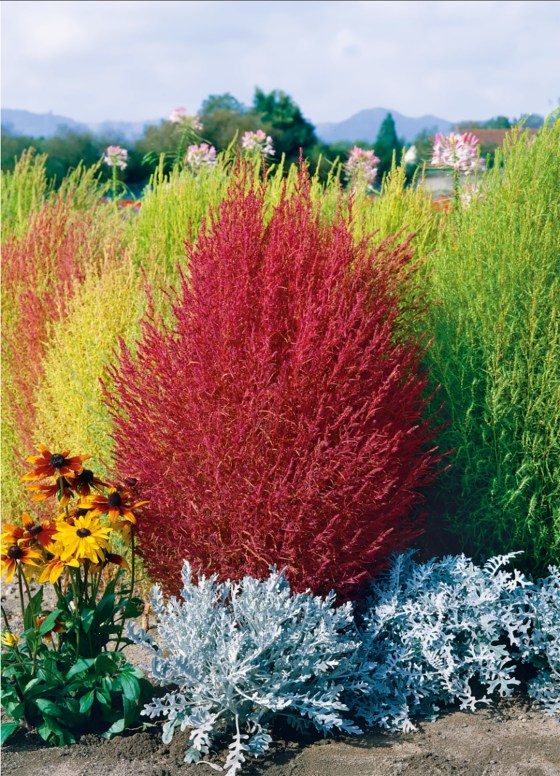
Kochia Burning Bush (E.W. Gaze / The Seed Company)
I was stumped by Hand’s reference to Viscaria Tom Thumb until I realized that Viscaria is a type of Lychnis, an old-fashioned cottage garden perennial for the border.
I reached out to Eileen Rosen, a Charleswood gardener who is an avid reader of garden history. Here’s what she says: “Viscaria is a low-growing white or pink plant. The flowers look like droopy flowers that resemble the tall Lychnis chalcedonica in red. It looks like a rock garden plant – mat forming with narrow leaves and droopy single flowers.”
In addition to many types of flowers that are still popular today for garden borders, Hand also paints a picture of an imaginative garden design that uses key architectural plants to achieve form and drama at the back of the border. Check it out!
Nightmare of elm seedlings
Have thousands of tree seedlings taken root in your flower beds and between your pavers? The recent years of drought have been stressful for tree species such as ash and elm and, in response, their seed production has gone into overdrive.
Some enterprising homeowners with large rural properties transplant the seedlings to pots that are large enough for the roots to grow and then plant them out in areas where trees are needed.
Heather Unger and Paul Kruse, owners of Northern Grove Tree Service & Permaculture, have relocated scores of tree seedlings on their property northeast of Winnipeg. It won’t be long before the tree seedlings repopulate a deforested area.
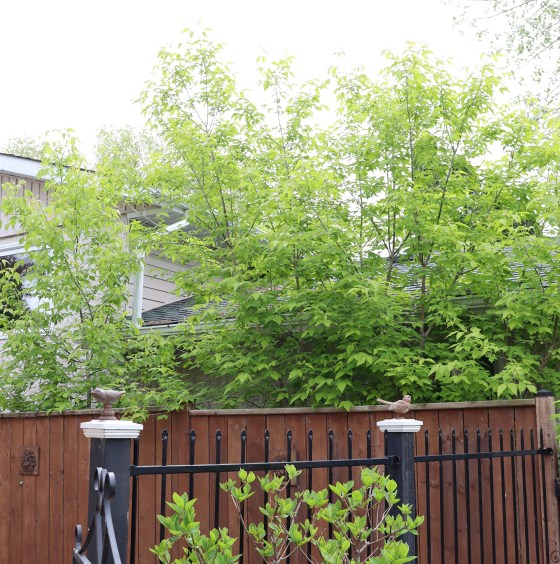
Ash tree seedlings grow up to be big trees. (Colleen Zacharias / Free Press)
This startling image shows ash tree seedlings that germinated in a tight space between a Winnipeg homeowner’s garage and a neighbour’s fence. Left undisturbed, tree seedlings grow up to be big trees.
But transplanting tens of thousands of tiny tree seedlings is not a viable option for urban homeowners. If tree seedlings have sprouted en masse in your flower beds or vegetable garden, there is little choice but to remove them.
They have a maddening habit of sprouting up in the centre of shrubs and perennials, which requires removal by hand.
The job is easiest while the stems of the seedlings are still soft. I’ve pulled out countless seedlings by hand this spring but older tree seedlings that I missed last year have already developed a semi-woody stem with roots as long as six inches (15.24 cm) or more. Removing those takes more effort than just a light tug.
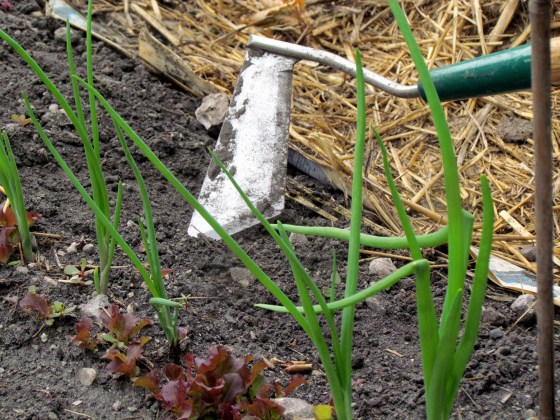
The swoe garden tool is used in a push-pull motion to cut off roots just below the soil surface.(Colleen Zacharias / Free Press)
A swoe is a type of hoe with a stainless-steel blade that is used in a push-pull motion to cut off roots just below the soil surface. It gets the job done quickly in open spaces, but be prepared for more seedlings to suddenly appear in the same area. Sustained attention will be needed.
Don’t be discouraged. This spring’s consistent moisture is welcome relief for stressed trees.
Cardboard tray fees
One of the biggest surprises of the spring shopping season has been a new 50-cent charge for cardboard greenhouse trays at retail garden centres. What are some of the reasons for the new fee?
Independent garden centres are largely family-run businesses, and many are seasonal operations. Garden centres typically operate on small margins.
Challenges in recent years that include supply chain disruptions, labor shortages, increased freight rates, and rising fuel costs were bound to have a trickle-down effect.
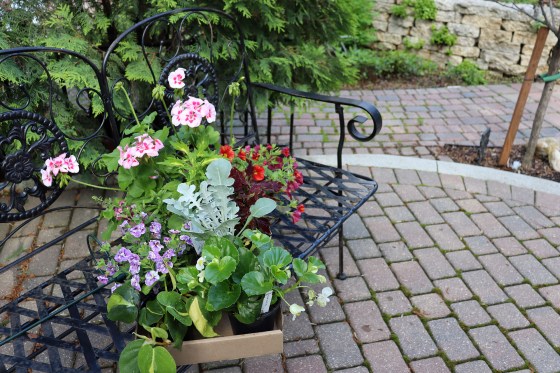
Fees for cardboard greenhouse trays began appearing last year. (Colleen Zacharias / Free Press)
Fees for cardboard greenhouse trays vary from region to region, but not every retail garden centre charges for the trays.
In spring 2023, Gaylene Yalowega recalls paying 10 cents for a cardboard greenhouse tray when she purchased bedding plants at her local garden centre in Winnipeg. Yalowega is a manager at Instabox, a Winnipeg-based, locally owned company that manufactures greenhouse trays using recycled material. I talked to Yalowega about cardboard greenhouse trays.
“In January 2024, there was a cardboard liner increase to anyone that manufactures boxes, so that included Instabox, Smart Box, Mid West Packaging, WestRock, and Cascades who are the larger players within Manitoba,” said Yalowega.
“We were hit with a seven percent increase across the board for the cost of linerboard, and that was predominately due to wildfires and the supply of paper products. But we as a company have absorbed that increase and have not passed it onto our customers. That may eventually have to happen but since January we have not done an increase.
“Since the production of cardboard garden trays is a seasonal industry that coincides with the spikes of when bedding plants are sold, we consolidate all our customers’ tray orders and run them in one production run to maximize production quantity of scale,” added Yalowega.
“Our end customer who has a greenhouse may purchase 2000 trays, for example, but they get the price point of running 100,000 trays because we run them all at one time. We order in our material at one time and manufacture at one time.”
Costs are increasing for everyone, gardeners included. It’s important to support local businesses and think outside the box, too. Choose the solution that works best for you. Plastic storage totes that can be used again and again are a good option when you are buying quantities of plants.
When you are finished with your stacks of cardboard trays or they can no longer be reused because of exposure to humidity or moisture, remember to add them to the recycle bin.
Plant picks for tough spots
Ground Hug Chokeberry (Aronia melanocarpa): This low-growing (H. 8 to 14 inches or 20 to 36 cm) shrub is native to North America. Need a plant for a difficult spot? Ground Hug is a great choice.
Ground Hug is salt tolerant, drought tolerant, and tolerant of dry or wet conditions. It’s also good for erosion control. Plant Ground Hug in a location where it will receive full sun to part sun.
With a spread of 36 inches or 91 cm, Ground Hug covers a lot of ground. In spring, it produces masses of small white flowers in spring. In fall, the glossy green foliage turns a beautiful reddish orange. Hardy to Zone 3a.
Ground Hug Chokeberry was originally sold under the name Ground Hog.
Giant Fleece Flower (Persicaria polymorpha): With a mature height of 59 to 78 inches (150 to 200 cm), this fast-growing perennial giant has a commanding presence in the garden. Easy to grow, Giant Fleece Flower is suitable for a full sun to part sun location that has average or moist soil. A low-maintenance plant, Giant Fleece Flower puts on an awesome display in summer with masses of fluffy white flowers. Looking for a large perennial for privacy and screening? This is the plant for you.

Giant Fleece Flower from Glenda MacPhee’s Neepawa garden. (Submitted)
Giant Fleece Flower is rabbit and deer resistant and attracts birds and butterflies. It was named the 2017 Perennial Plant of the Year and is hardy to Zone 3a. It is not only long blooming but also long-lived (15 years or more).
Tulips in pots
Tulip season is over, and Elsie Kathler couldn’t be happier with how her tulip experiment turned out.
Kathler is a member of the Steinbach and Area Garden Club and the Manitoba Master Gardener Association. Last fall – Oct. 15, to be exact — Kathler planted tulip bulbs in large plastic pots filled with leftover potting soil from annuals she had grown during the summer.
She watered the pots thoroughly and left them outside for a day so that the pots were well drained.

Tulips planted in pots and overwintered in a garage. (Elsie Kathler photo)
Next, she moved the pots into her garage and placed them on a piece of cardboard near the garage wall and covered the pots with a cardboard box. Kathler left the pots as they were for the duration of the winter.
“On April 7, I checked the pots and saw that the tulips were peeking out through the soil by about two inches (5.08 cm). I moved the pots outdoors to a south-facing deck and placed them against the wall of the house.”
At night, if frost was in the forecast, she covered the pots with a blanket, which she removed during the daytime.
Kathler found this process much easier than planting tulips in pots and heeling them into her vegetable garden. (“Heeling” is the term for sinking a pot into the ground for overwintering.)
“Digging out the pots from the veggie garden had to be delayed until the ground was thawed out sufficiently. There was the messy task of washing the soil off the pots.”
Kathler was delighted to have homegrown tulips this spring and plans to repeat her success.
Storing peony buds to bloom later
It’s June and that means glorious peony flowers. Would you like to store peony buds for later use?
Myra Froc, president of the Prairie Peony Society, shares the following tips which PPS members will be using in preparation for their annual peony show (June 22-23 in Regina):
- Take the bud between your fingers. It should feel like a soft marble. If it feels like a hard marble, it is too soon to cut the stem.
- If the petals are loose and have already started to unfurl, you will only be able to store the buds in your refrigerator for a few days.
- Cut the stem an inch or so longer than needed and remove the leaves.
- Wrap the stems in sticky plastic food wrap (ex. Press’n Seal). Cover the entire stem, bud and all. Label the wrapped blossom with a sharpie marker.
- Place the plastic-wrapped stems in a jumbo-sized plastic food storage bag and ensure it is tightly closed. Do not add any water or wet paper towels.
- Lay bag flat in your refrigerator. Bags of stems can be stacked on top of each other.
By following the above steps, your peony buds can be stored in your refrigerator for a few weeks, says Froc.

The peony bud should feel like a soft marshmallow but not have loose petals. (Becky Slater photo)
When it’s time to bring your peony buds out of storage, remove them carefully from their wrapping.
Froc recommends recutting one inch (2.54 cm) off the bottom of the stems under lukewarm water.
Place the flowers in a vase or container that is filled with room-temperature water.
Reblooming Irises
The CanWest Iris Society celebrates its 20th anniversary this year and will hold its first iris show since the pandemic on Sunday, June 19 at the Bourkevale Community Centre, 100 Ferry Rd. Beautiful irises will be on display.
I asked Barbara-Jean Jackson, a longtime member of the CanWest Iris Society and show chair, if there are reblooming irises that will grow in Manitoba.
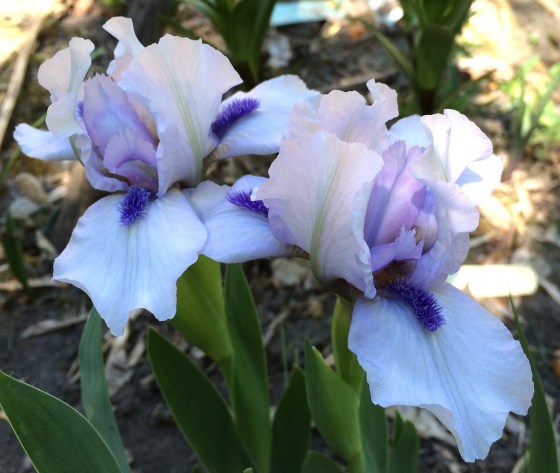
Forever Blue, a standard dwarf bearded iris was developed by iris breeder Chuck Chapman. (Barbara-Jean Jackson photo)
“Most (reblooming irises) do not rebloom every year for everyone,” says Jackson. “Immortality, a tall-bearded iris, is a reliable rebloomer in Manitoba if it is happy. It has never been happy for me, though, because I have tried it several times in several areas with no luck.”
Jackson says that Forever Blue, a standard dwarf bearded iris developed by iris breeder Chuck Chapman (chapmaniris.com), is a more reliable rebloomer which has rebloomed several times for CWIS members.
Here is a list compiled by Jackson of some other reblooming irises that have been known to rebloom in Manitoba:
- Encore Performance (Siberian)
- Jillaroo (Standard Dwarf Bearded)
- Forever Violet (Miniature Dwarf Bearded)
- Many Mahalos (Intermediate Bearded)
- Immortality (Tall Bearded)
- Autumn Jester (Standard Dwarf Bearded)
- Jewel Baby (Standard Dwarf Bearded)
Designing with dwarf conifers
This spring van der Meer Garden Centre in Île-des-Chênes is offering a range of dwarf conifers from Iseli Nursery, a wholesale grower in Oregon which specializes in dwarf conifers.
Lori van der Meer has created container gardens in glazed ceramic bowls using enchanting miniatures in a mix of shapes, colours, and textures.
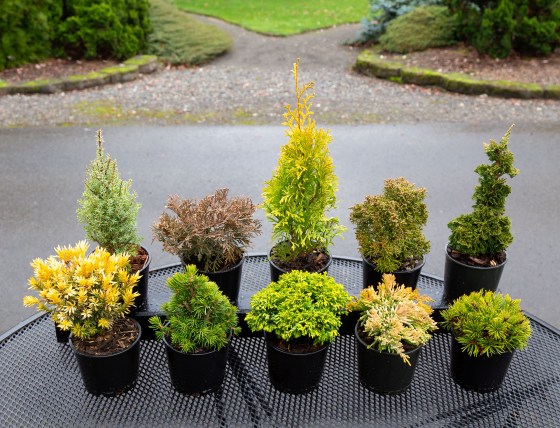
Dwarf Conifers for patio containers. The plants come in a mix of shapes, colours, and textures. (Iseli Nursery)
Van der Meer has combined dwarf conifers with groundcovers such as Sedum Chocolate Ball and Cobweb Hens and Chicks.
Dwarf conifers can also be bought separately if you want to create your own patio bowl design.
Varieties include:
- Chamaecyparis pisifera Golden Pin Cushion Cypress,
- Juniperus chinensis Shimpaku,
- Juniperus communis Miniature,
- Juniperus horizontalis Mother Lode,
- Microbiota decussata Siberian Cypress,
- Picea abies Tompa,
- Taxus cuspidata Nana Aurescens,
- Thuja occidentalis Jantar, and
- Thuja occidentalis Primo Arborvitae.
FAQ: Growing tomatoes
Every year Ed Amman starts more than 100 tomato plants in his Winnipeg garden. This year he is growing 10 different varieties.
This year Amman is once again growing Mexico heirloom tomato.
“It is an indeterminate variety that is slightly pink in colour,” he says. “I was impressed with it last year. The tomatoes were quite large, and the plant was quite productive. I have found that many of the large beefsteak plants do not produce a lot of tomatoes.”
I asked Amman some of the top questions about growing tomatoes:
When and where should tomato plants be pinched?
The only time I do any pinching is to remove some of the suckers on indeterminate tomato plants that form by the main stem. That would be around the time the plant starts producing flowers.
I find this keeps the plant from getting too heavy and helps to increase air circulation, which reduces disease problems.
In late August, I pinch the main stem of indeterminate tomato plants in the hope of ripening the fruit that is on the plant.
The only pruning needed on determinate plants is to remove lower leaves, which are prone to soil-borne diseases.
What should be done with leggy tomato plants?
If plants are leggy at planting time, plant the tomato deeper, or you could bury a lot of the stem sideways. Roots will form along the buried stem.
Does sprinkling Epsom salts around tomato plants really work to prevent blossom end rot?
I don’t use Epsom salts. I have added calcium in the past, but I believe the real problem with blossom end rot is infrequent watering.
In past years when we had wetter summers, blossom end rot wasn’t such a big problem unless you were growing tomatoes in containers. I water regularly and put a mulch around all my tomato plants and have been able to minimize any problems.
Rhubarb woes
Leigh-Anne Peterson is the treasurer of the Lindenwoods Garden Club, which has a plot of about 25 rhubarb plants. Symptoms of fungus began appearing three years ago and have now spread to three-quarters of the plants.
“The plants are spaced evenly in the plot,” says Peterson. “The plot is in full sun and there is no standing water. We have done a complete harvest of all the plant stalks mid-season for the past two years and all waste is discarded into the garbage. New growth still shows red spots and holes on the leaves.”

Rhubarb leaves with leaf spot fungus. (Leigh-Anne Peterson photo)
Peterson would like to know what the problem is with the rhubarb plants and what should be done.
To answer her question, I reached out to Anthony Mintenko, provincial fruit crops specialist and to Carl Durand, a rhubarb grower.
Add compost
Mintenko says the problem is leaf spot and recommends removing the rhubarb stalk and leaves and applying good-quality compost at a rate of ¾ to 1½ lbs per square foot.
Durand owns Futura Farms in Selkirk, where he grows a large crop of rhubarb for the local beverage industry. He says that while the location of the rhubarb plot maintained by the garden club sounds ideal, the biggest question is: how old are the rhubarb plants and when was the last time they were split?
For best growth, says Durand, rhubarb plants should be divided every five or six years.
“If you go long periods without splitting, the rhubarb roots start to get congested and the growth each year will suffer.”
It is important, he says, to harvest no more than 50 percent of a rhubarb plant each year and leave half of the leaves to photosynthesize and power up the root for the following spring.
“The poor growth and quality of the rhubarb stalks is likely related to one of those two things and not the leaf spot disease. However, a rhubarb plant that is producing small, pithy stalks due to overharvesting or needing to be split (or both) is likely more stressed and more susceptible to disease in general.”
Divide and wait
Durand recommends removing all infected leaves which contain the leaf spot fungus. If the plants have not been divided recently, they should be divided as soon as possible.
“Unfortunately, it is getting a little late in the season, but if they are diligent with watering the newly planted split crowns, it can still be done. Otherwise, it should be done as soon as the frost is out next spring.”
Once the plants have been split and replanted, Durand says that no rhubarb should be harvested for at least two growing seasons.
“Once the new healthy plants are established, the owner will likely find that the stalks are much larger and healthier,” says Durand.
“If the newly split plants are still covered in leaf spot even after diligently removing the infected leaves the previous season, then the only option left would be to completely remove the rhubarb and plant something else there instead.”
Grass under an evergreen
Deborah Schadek asks, “Can I treat the soil under my evergreen with a type of lime to neutralize the soil in my flower bed and help the grass to grow around it?”
Ken Land, co-owner of St. Mary’s Nursery, has a Bachelor of Science in Agriculture and is knowledgeable about the use of soil amendments and fertilizers. He answers Schadek’s question:
“Around evergreens, spruce trees in particular, the needle drop helps to acidify the soil, which evergreen trees prefer. You can raise the pH of the soil around your tree by adding dolomitic lime, but your evergreen tree isn’t going to like that.
“So, you have to decide whether you are more concerned about the health of the grass or the health of the evergreen.
“Often, we assume that grass is not growing well around an evergreen because of the acidity from the needles that drop. But in reality, the evergreen tree is far more competitive than the lawn around it for moisture and nutrients in the soil.
“It won’t make much difference if dolomite lime is added to the soil beneath an evergreen, because the grass around the tree is still going to do poorly.
“If the soil area beneath the tree extends all the way out to the end of the evergreen’s branches, the grass won’t receive as much shade and will have more access to moisture.
“Keep in mind, though, that the feeder roots of evergreens start at the branches and move out from there, so those feeder roots are competing with the grass.
“The only way to keep grass growing really well in the immediate vicinity of an evergreen tree is to significantly increase the amount of water and fertilizer that you are applying to your lawn.
“If you can go to all the trouble to do that then you can keep the grass green and growing and relatively healthy. But adding lime is usually not the main issue.”
Mark your calendars
The Can-West Iris Society will host its 13th Iris Show on Sunday, June 9 at the Bourkevale Community Centre, 100 Ferry Rd. from 1:30 p.m. to 4 p.m. Admission is free.
The Urban Retreats Garden Tour celebrates its 25th anniversary on June 22 from 10 a.m. to 4 p.m. This year’s garden tour features 14 gardens in the Charleswood area. Tickets for the tour are $20 and can be purchased online at www.1JustCity.ca. Tickets are also available at several local garden centres. The tour also includes the Manitoba Tea, Craft and Plant Sale at Charleswood United Church, 4820 Roblin Blvd., 10 a.m. to 2 p.m. Tickets are $5 and can be purchased at the door.
The Prairie Peony Society celebrates 25 years of “Passion for Peonies” June 22-23 at the Cathedral Community Centre, 2900 13th Ave., in Regina, 7 a.m. to 3 p.m. both days. For more information, please contact Myra Froc at mfroc@sasktel.net
Nature Manitoba hosts its 2024 Gardens of Distinction fundraising event on July 6. Established in 2000, this self-guided tour features 13 gardens in the St. Vital, St. Boniface and Osborne Village areas between 9 a.m. and 4 p.m. Tickets are $20 and are available at www.naturemanitoba.ca or at local garden centres (a full list of retail locations are available online).
|

